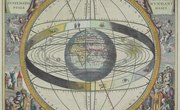
An armillary sphere is a tool that can be used to solve various astronomical problems or as an educational tool to represent movements in the heavens. It was once common to use armillary spheres to teach the differences between the Ptolemaic model, named for Greek astronomer Ptolemy, and the Copernican model, named for Polish astronomer Copernicus, of the universe. An armillary sphere can be used to track the path of the sun for a given day of the year or to determine the coordinates of a star, among other things.
History
The armillary sphere originated in ancient Greece, where it was used primarily as a teaching instrument, although bigger versions were used as observational tools. Originally, the sphere in the center of the instrument represented the Earth, according to the Ptolemaic model of the universe, but as the Copernican model grew more influential, the sphere came to represent the sun. Often, armillary spheres were built in pairs, with one representing each model, to teach the differences between the two.
From the late medieval period, numerous artistic representations have survived that show the South Pole extending downwards to form a handle. That style of armillary sphere persisted through to the early modern era, but in the 16th and 17th centuries, it became more common for them to be built with stands and cradles along with a horizon ring.
Time Frame
It’s unclear exactly when armillary spheres were first invented. Some believe that they were invented by Eratosthenes, a Greek astronomer, around 255 BC, but the lack of detail in the writings of various Greek and Roman commentators and historians casts some doubt on this assertion. Armillary spheres were also invented in China in the first century AD, independent of Western influences.
In Europe, armillary spheres were common in the late medieval period and through the early modern era. Many surviving armillary spheres from the 1500s and after indicate that they were made from precious metals for collectors. In the 18th century, armillary spheres were also made from wood and pasteboard. They were used through the 19th century, primarily as educational tools to teach the difference between the Ptolemaic and Copernican models of the universe.
Types
Armillary spheres can be divided into two main categories: observational armillary spheres and demonstrational instruments. The former is the type used by Ptolemy and Danish astronomerTycho Brahe, which tend to be bigger than demonstrational armillary spheres and have fewer rings, which makes them both more accurate and easier to use.
Function
Armillary spheres were used by setting them to the appropriate latitude by setting the outer meridian rings in a position perpendicular to the horizon and parallel to a line drawn from north to south. Their orientation was established by sighting a celestial object (star, sun, moon or planet) whose position on the ecliptic was known, using a divided ecliptic ring and a ring corresponding to the latitude. The position of a body on the ecliptic could be found using a divided inner latitude ring that held an inner ring which could be turned without disrupting the latitude ring.
Parts
Armillary spheres have a central sphere representing either the Earth or the sun. They have graduated rings representing circles on celestial sphere, such as:
- the meridian
- equator
- ecliptic horizon
- tropics
- colures
The rings defining the sphere (the colures and equator) represent the firmament, the sphere on which fixed stars lie. The band going around the sphere at an angle to the equator represents the constellations of the zodiac. The line that runs through that band is the ecliptic, the path the sun follows across the sky. The stand may be decorative, but also allows you to place the sun in its astrological house for a given date and to demonstrate the times of sunrise and sunset.
References
About the Author
Emily Willis is a university student who began writing in 2009, primarily with eHow. Currently, she is working on obtaining a B.A. in English from the University of Portland.
Photo Credits
ancient chinese armillary sphere image by Yali Shi from Fotolia.com
